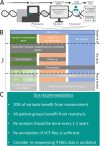Re-evaluation and re-analysis of 152 research exomes five years after the initial report reveals clinically relevant changes in 18
- PMID: 37460657
- PMCID: PMC10545662
- DOI: 10.1038/s41431-023-01425-6
Re-evaluation and re-analysis of 152 research exomes five years after the initial report reveals clinically relevant changes in 18
Abstract
Iterative re-analysis of NGS results is not well investigated for published research cohorts of rare diseases. We revisited a cohort of 152 consanguineous families with developmental disorders (NDD) reported five years ago. We re-evaluated all reported variants according to diagnostic classification guidelines or our candidate gene scoring system (AutoCaSc) and systematically scored the validity of gene-disease associations (GDA). Sequencing data was re-processed using an up-to-date pipeline for case-level re-analysis. In 28/152 (18%) families, we identified a clinically relevant change. Ten previously reported (likely) pathogenic variants were re-classified as VUS/benign. In one case, the GDA (TSEN15) validity was judged as limited, and in five cases GDAs are meanwhile established. We identified 12 new disease causing variants. Two previously reported variants were missed by our updated pipeline due to alignment or reference issues. Our results support the need to re-evaluate screening studies, not only the negative cases but including supposedly solved ones. This also applies in a diagnostic setting. We highlight that the complexity of computational re-analysis for old data should be weighed against the decreasing re-testing costs. Since extensive re-analysis per case is beyond the resources of most institutions, we recommend a screening procedure that would quickly identify the majority (83%) of new variants.
© 2023. The Author(s).
Conflict of interest statement
The authors declare no competing interests.
Figures


Comment in
-
Unveiling the hidden: revisiting the potential of old genetic data for rare disease research.Eur J Hum Genet. 2023 Oct;31(10):1093-1094. doi: 10.1038/s41431-023-01435-4. Epub 2023 Jul 20. Eur J Hum Genet. 2023. PMID: 37474787 Free PMC article. No abstract available.
Similar articles
-
AutoCaSc: Prioritizing candidate genes for neurodevelopmental disorders.Hum Mutat. 2022 Dec;43(12):1795-1807. doi: 10.1002/humu.24451. Epub 2022 Sep 14. Hum Mutat. 2022. PMID: 35998261
-
Diagnostic Yield and Novel Candidate Genes by Exome Sequencing in 152 Consanguineous Families With Neurodevelopmental Disorders.JAMA Psychiatry. 2017 Mar 1;74(3):293-299. doi: 10.1001/jamapsychiatry.2016.3798. JAMA Psychiatry. 2017. PMID: 28097321
-
The future of Cochrane Neonatal.Early Hum Dev. 2020 Nov;150:105191. doi: 10.1016/j.earlhumdev.2020.105191. Epub 2020 Sep 12. Early Hum Dev. 2020. PMID: 33036834
-
Parental exome analysis identifies shared carrier status for a second recessive disorder in couples with an affected child.Eur J Hum Genet. 2021 Mar;29(3):455-462. doi: 10.1038/s41431-020-00756-y. Epub 2020 Nov 22. Eur J Hum Genet. 2021. PMID: 33223529 Free PMC article.
-
A biallelic loss of function variant in HORMAD1 within a large consanguineous Turkish family is associated with spermatogenic arrest.Hum Reprod. 2023 Feb 1;38(2):306-314. doi: 10.1093/humrep/deac259. Hum Reprod. 2023. PMID: 36524333
Cited by
-
Routine Diagnostics Confirm Novel Neurodevelopmental Disorders.Genes (Basel). 2022 Dec 7;13(12):2305. doi: 10.3390/genes13122305. Genes (Basel). 2022. PMID: 36553572 Free PMC article.
-
Unveiling the hidden: revisiting the potential of old genetic data for rare disease research.Eur J Hum Genet. 2023 Oct;31(10):1093-1094. doi: 10.1038/s41431-023-01435-4. Epub 2023 Jul 20. Eur J Hum Genet. 2023. PMID: 37474787 Free PMC article. No abstract available.
-
Expanding what we know about rare genetic diseases.Eur J Hum Genet. 2023 Oct;31(10):1091-1092. doi: 10.1038/s41431-023-01453-2. Eur J Hum Genet. 2023. PMID: 37783763 Free PMC article. No abstract available.
-
Molecular mechanisms of human overgrowth and use of omics in its diagnostics: chances and challenges.Front Genet. 2024 Jun 4;15:1382371. doi: 10.3389/fgene.2024.1382371. eCollection 2024. Front Genet. 2024. PMID: 38894719 Free PMC article. Review.
-
Diagnostic yield of exome and genome sequencing after non-diagnostic multi-gene panels in patients with single-system diseases.Orphanet J Rare Dis. 2024 May 24;19(1):216. doi: 10.1186/s13023-024-03213-x. Orphanet J Rare Dis. 2024. PMID: 38790019 Free PMC article.
References
Publication types
MeSH terms
Substances
LinkOut - more resources
Full Text Sources

